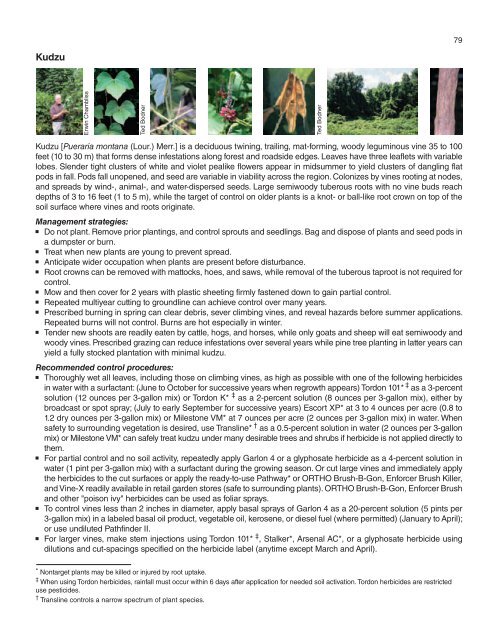A Management Guide for Invasive Plants in Southern Forests James ...
A Management Guide for Invasive Plants in Southern Forests James ...
A Management Guide for Invasive Plants in Southern Forests James ...
- No tags were found...
You also want an ePaper? Increase the reach of your titles
YUMPU automatically turns print PDFs into web optimized ePapers that Google loves.
79KudzuErw<strong>in</strong> ChamblissTed BodnerTed BodnerKudzu [Pueraria montana (Lour.) Merr.] is a deciduous tw<strong>in</strong><strong>in</strong>g, trail<strong>in</strong>g, mat-<strong>for</strong>m<strong>in</strong>g, woody legum<strong>in</strong>ous v<strong>in</strong>e 35 to 100feet (10 to 30 m) that <strong>for</strong>ms dense <strong>in</strong>festations along <strong>for</strong>est and roadside edges. Leaves have three leaflets with variablelobes. Slender tight clusters of white and violet pealike flowers appear <strong>in</strong> midsummer to yield clusters of dangl<strong>in</strong>g flatpods <strong>in</strong> fall. Pods fall unopened, and seed are variable <strong>in</strong> viability across the region. Colonizes by v<strong>in</strong>es root<strong>in</strong>g at nodes,and spreads by w<strong>in</strong>d-, animal-, and water-dispersed seeds. Large semiwoody tuberous roots with no v<strong>in</strong>e buds reachdepths of 3 to 16 feet (1 to 5 m), while the target of control on older plants is a knot- or ball-like root crown on top of thesoil surface where v<strong>in</strong>es and roots orig<strong>in</strong>ate.<strong>Management</strong> strategies:Do not plant. Remove prior plant<strong>in</strong>gs, and control sprouts and seedl<strong>in</strong>gs. Bag and dispose of plants and seed pods <strong>in</strong>a dumpster or burn.Treat when new plants are young to prevent spread.Anticipate wider occupation when plants are present be<strong>for</strong>e disturbance.Root crowns can be removed with mattocks, hoes, and saws, while removal of the tuberous taproot is not required <strong>for</strong>control.Mow and then cover <strong>for</strong> 2 years with plastic sheet<strong>in</strong>g firmly fastened down to ga<strong>in</strong> partial control.Repeated multiyear cutt<strong>in</strong>g to groundl<strong>in</strong>e can achieve control over many years.Prescribed burn<strong>in</strong>g <strong>in</strong> spr<strong>in</strong>g can clear debris, sever climb<strong>in</strong>g v<strong>in</strong>es, and reveal hazards be<strong>for</strong>e summer applications.Repeated burns will not control. Burns are hot especially <strong>in</strong> w<strong>in</strong>ter.Tender new shoots are readily eaten by cattle, hogs, and horses, while only goats and sheep will eat semiwoody andwoody v<strong>in</strong>es. Prescribed graz<strong>in</strong>g can reduce <strong>in</strong>festations over several years while p<strong>in</strong>e tree plant<strong>in</strong>g <strong>in</strong> latter years canyield a fully stocked plantation with m<strong>in</strong>imal kudzu.Recommended control procedures:Thoroughly wet all leaves, <strong>in</strong>clud<strong>in</strong>g those on climb<strong>in</strong>g v<strong>in</strong>es, as high as possible with one of the follow<strong>in</strong>g herbicides<strong>in</strong> water with a surfactant: (June to October <strong>for</strong> successive years when regrowth appears) Tordon 101* ‡ as a 3-percentsolution (12 ounces per 3-gallon mix) or Tordon K* ‡ as a 2-percent solution (8 ounces per 3-gallon mix), either bybroadcast or spot spray; (July to early September <strong>for</strong> successive years) Escort XP* at 3 to 4 ounces per acre (0.8 to1.2 dry ounces per 3-gallon mix) or Milestone VM* at 7 ounces per acre (2 ounces per 3-gallon mix) <strong>in</strong> water. Whensafety to surround<strong>in</strong>g vegetation is desired, use Transl<strong>in</strong>e* † as a 0.5-percent solution <strong>in</strong> water (2 ounces per 3-gallonmix) or Milestone VM* can safely treat kudzu under many desirable trees and shrubs if herbicide is not applied directly tothem.For partial control and no soil activity, repeatedly apply Garlon 4 or a glyphosate herbicide as a 4-percent solution <strong>in</strong>water (1 p<strong>in</strong>t per 3-gallon mix) with a surfactant dur<strong>in</strong>g the grow<strong>in</strong>g season. Or cut large v<strong>in</strong>es and immediately applythe herbicides to the cut surfaces or apply the ready-to-use Pathway* or ORTHO Brush-B-Gon, En<strong>for</strong>cer Brush Killer,and V<strong>in</strong>e-X readily available <strong>in</strong> retail garden stores (safe to surround<strong>in</strong>g plants). ORTHO Brush-B-Gon, En<strong>for</strong>cer Brushand other "poison ivy" herbicides can be used as foliar sprays.To control v<strong>in</strong>es less than 2 <strong>in</strong>ches <strong>in</strong> diameter, apply basal sprays of Garlon 4 as a 20-percent solution (5 p<strong>in</strong>ts per3-gallon mix) <strong>in</strong> a labeled basal oil product, vegetable oil, kerosene, or diesel fuel (where permitted) (January to April);or use undiluted Pathf<strong>in</strong>der II.For larger v<strong>in</strong>es, make stem <strong>in</strong>jections us<strong>in</strong>g Tordon 101* ‡ , Stalker*, Arsenal AC*, or a glyphosate herbicide us<strong>in</strong>gdilutions and cut-spac<strong>in</strong>gs specified on the herbicide label (anytime except March and April).* Nontarget plants may be killed or <strong>in</strong>jured by root uptake.‡ When us<strong>in</strong>g Tordon herbicides, ra<strong>in</strong>fall must occur with<strong>in</strong> 6 days after application <strong>for</strong> needed soil activation. Tordon herbicides are restricteduse pesticides.† Transl<strong>in</strong>e controls a narrow spectrum of plant species.
















